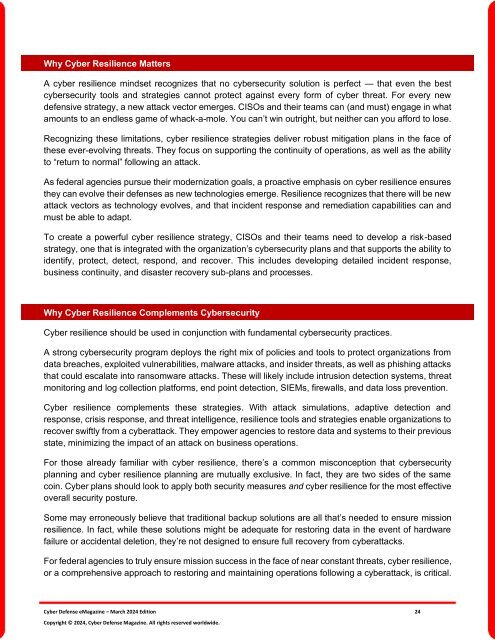The Cyber Defense eMagazine March Edition for 2024
Cyber Defense eMagazine March Edition for 2024 #CDM #CYBERDEFENSEMAG @CyberDefenseMag by @Miliefsky a world-renowned cyber security expert and the Publisher of Cyber Defense Magazine as part of the Cyber Defense Media Group as well as Yan Ross, Editor-in-Chief and many more writers, partners and supporters who make this an awesome publication! 225 page March Edition fully packed with some of our best content. Thank you all and to our readers! OSINT ROCKS! #CDM #CDMG #OSINT #CYBERSECURITY #INFOSEC #BEST #PRACTICES #TIPS #TECHNIQUES
Cyber Defense eMagazine March Edition for 2024 #CDM #CYBERDEFENSEMAG @CyberDefenseMag by @Miliefsky a world-renowned cyber security expert and the Publisher of Cyber Defense Magazine as part of the Cyber Defense Media Group as well as Yan Ross, Editor-in-Chief and many more writers, partners and supporters who make this an awesome publication! 225 page March Edition fully packed with some of our best content. Thank you all and to our readers! OSINT ROCKS! #CDM #CDMG #OSINT #CYBERSECURITY #INFOSEC #BEST #PRACTICES #TIPS #TECHNIQUES
Create successful ePaper yourself
Turn your PDF publications into a flip-book with our unique Google optimized e-Paper software.
Why <strong>Cyber</strong> Resilience Matters<br />
A cyber resilience mindset recognizes that no cybersecurity solution is perfect — that even the best<br />
cybersecurity tools and strategies cannot protect against every <strong>for</strong>m of cyber threat. For every new<br />
defensive strategy, a new attack vector emerges. CISOs and their teams can (and must) engage in what<br />
amounts to an endless game of whack-a-mole. You can’t win outright, but neither can you af<strong>for</strong>d to lose.<br />
Recognizing these limitations, cyber resilience strategies deliver robust mitigation plans in the face of<br />
these ever-evolving threats. <strong>The</strong>y focus on supporting the continuity of operations, as well as the ability<br />
to “return to normal” following an attack.<br />
As federal agencies pursue their modernization goals, a proactive emphasis on cyber resilience ensures<br />
they can evolve their defenses as new technologies emerge. Resilience recognizes that there will be new<br />
attack vectors as technology evolves, and that incident response and remediation capabilities can and<br />
must be able to adapt.<br />
To create a powerful cyber resilience strategy, CISOs and their teams need to develop a risk-based<br />
strategy, one that is integrated with the organization’s cybersecurity plans and that supports the ability to<br />
identify, protect, detect, respond, and recover. This includes developing detailed incident response,<br />
business continuity, and disaster recovery sub-plans and processes.<br />
Why <strong>Cyber</strong> Resilience Complements <strong>Cyber</strong>security<br />
<strong>Cyber</strong> resilience should be used in conjunction with fundamental cybersecurity practices.<br />
A strong cybersecurity program deploys the right mix of policies and tools to protect organizations from<br />
data breaches, exploited vulnerabilities, malware attacks, and insider threats, as well as phishing attacks<br />
that could escalate into ransomware attacks. <strong>The</strong>se will likely include intrusion detection systems, threat<br />
monitoring and log collection plat<strong>for</strong>ms, end point detection, SIEMs, firewalls, and data loss prevention.<br />
<strong>Cyber</strong> resilience complements these strategies. With attack simulations, adaptive detection and<br />
response, crisis response, and threat intelligence, resilience tools and strategies enable organizations to<br />
recover swiftly from a cyberattack. <strong>The</strong>y empower agencies to restore data and systems to their previous<br />
state, minimizing the impact of an attack on business operations.<br />
For those already familiar with cyber resilience, there’s a common misconception that cybersecurity<br />
planning and cyber resilience planning are mutually exclusive. In fact, they are two sides of the same<br />
coin. <strong>Cyber</strong> plans should look to apply both security measures and cyber resilience <strong>for</strong> the most effective<br />
overall security posture.<br />
Some may erroneously believe that traditional backup solutions are all that’s needed to ensure mission<br />
resilience. In fact, while these solutions might be adequate <strong>for</strong> restoring data in the event of hardware<br />
failure or accidental deletion, they’re not designed to ensure full recovery from cyberattacks.<br />
For federal agencies to truly ensure mission success in the face of near constant threats, cyber resilience,<br />
or a comprehensive approach to restoring and maintaining operations following a cyberattack, is critical.<br />
<strong>Cyber</strong> <strong>Defense</strong> <strong>eMagazine</strong> – <strong>March</strong> <strong>2024</strong> <strong>Edition</strong> 24<br />
Copyright © <strong>2024</strong>, <strong>Cyber</strong> <strong>Defense</strong> Magazine. All rights reserved worldwide.

















